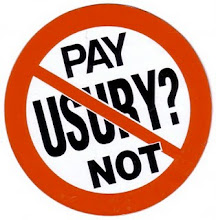The Problem of Interest (Usury)
By Mark Smith
- ● Currently Governments create a currency monopoly with legal tender laws and then hands over this monopoly to a private central banking cartel, destroying us with interest.All the world's money in every country is created as an interest bearing debt by private banks. The U.S Government currently pay $700 billion per year in debt service for the National Debt. The UK government pays £100-200 billion to banks as interest per year. Governments could and should create their own money interest free.● Interest is a wealth transfer from poor to rich. Margrit Kennedy, a German monetarist, has quantified this wealth transfer in Germany. Her conclusions: the 80% poorest Germans pay 1 billion euros per day (365 billion per year) in interest to the richest 10%. The next richest 10% pay about as much interest as they receive.Also, within the 10% brackets the same wealth transfer is happening: so the poorest 8% of the richest 10% pay interest to the richest 1%.The situation is more or less the same in every country.The poorest 80% Americans pay about 1.5 trillion dollars per year to the richest 10 percent.The world’s poorest 80% pay between 5 and 10 trillion per year to the richest 10%.● Even if you don’t have any debts at all, you will still lose up to 45% of your disposable income through interest. On average 45% of prices we pay for our daily needs are compensation for capital. Producers incur ‘capital costs’. They pass these costs on to their customers. The amount of interest they pay on the loans to finance their production differs per sector. In construction a whopping 75% of prices are related to costs for capital. Meaning that if we buy a new $100,000 home, $75,000 is lost to banks and other financiers.● When we buy the house with a mortgage, we will not only pay $100,000 for the house, but an additional $150,000 in interest over 30 years. So we pay a total of $250,000 for a house that actually costs no more than $25,000 to build.Margrit Kennedy's famous 'Why do we need Monetary Innovation', explaining the wealth transfer from the 80% to the richest 10% and the stunning effect of usury on prices.
NOTE: This article is originally posted on Mark Smith's wall at Facebook on August 7, 2013.
posted by usuryfree @ 1:36 PM
![]()
![]()



0 Comments:
Post a Comment
<< Home